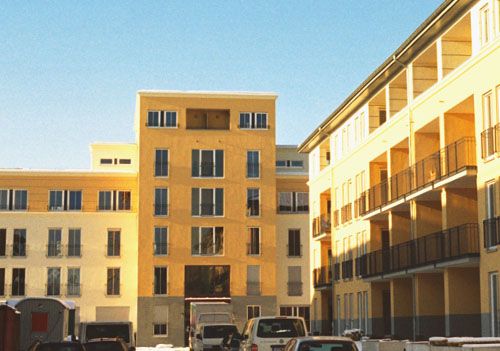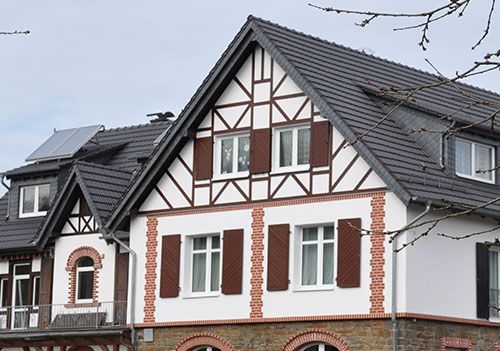

| object | housing complex Sonnenstraße 99-105, Düsseldorf |
| constructor | Boss Bau GmbH & Co KG, Düsseldorf |
| architect | Architekturbüro Schwingen, Düsseldorf |
| planning | PBS & Partner, Erkrath |
| construction year | 2005 - 2006 |
| heat source | earth |
| heat pump | Typ DS 5194.3, 150 kW |
| collector | 18 vertical probe à 100 m |
| operation mode | heating with heat recovery |
In 2006, when the first residents moved into Sonnenstraße 99-105 in Düsseldorf, this complex was considered the largest geothermally heated housing development in North Rhine Westphalia. A total of 1800m geothermal probes heat the 50 privately financed apartments which are divided into two to four room units. Heat requirement EnEV standard.
Apart from the probe field, the heat pump and heat recovery from six hot water tanks à 950 l, the heat supply consists of an additional divided tank and high-performance heat exchanger for each apartment. This 54 kW decentralised plate heat exchanger ensures the hot water supply for kitchen and bath.
Concerning heat supply, the six hot water tanks take priority over heating. Depending on time of day and season, the control could therefore possibly take the floor heating coils off the grid for half an hour or a whole hour. Even though the large circulating water quantity should be able to bridge a certain period without noticeable impact on the room temperatures, the planners considered the priority function of the hot water production a certain residual risk. For this reason, they integrated a 950 l divided tank to basically perform two tasks: For the benefit of longer heat pump service life due to the larger water volume that must be heated now and, as mentioned, for the benefit of sufficient heat supply.

| object | two row houses with 15 apartments, Cloppenburger Weg, Düsseldorf |
| constructor | Boss Bau GmbH & Co. KG, Düsseldorf |
| architect | Architekturbüro Schwingen, Düsseldorf |
| planning | PBS & Partner, Erkrath |
| construction year | 2006 |
| heat source | earth |
| heat pump | DS 5072.3; 71,8 kW, Tandem- model (2 compressor) |
| collector | 9 vertical probe à 70 m |
| operation mode | heating with heat recorvery |
The 15 apartments on Cloppenburger Weg in Düsseldorf that are heated be heat pumps and floor heat have an average living space of 85 qm. The structural characteristics of both buildings, which were built in 2006, comply with the normal EnEv house standard. Since the consumer behaviour has a high impact on heat consumption, the builder Bossbau did not invest in insulation measures that exceed the EnEV since their advantage is lost when the windows remain open. However, the improved effectiveness of an efficient heating technology is always of advantage to the heating costs.
The heat pump operates on two condensing boilers, one for heating, one for domestic water. For the domestic water, the planners provided a tank capacity of 1900 litres with a temperature level of 55 °C. The determination of this volume included a coincidence observation of the 15 apartments, primarily in terms of shower water requirement in the morning hours. The tank must be able to cover a specific peak coincidence over a period of approx. 1.5 hours.

| object | Complex Niehler WohnArt, ca. 400 apartments/ single family houses |
| constructor/ architect | GAG Immobilien AG, Köln |
| planning | CommonConsult, Herne |
| construction year | 2007 – 2009/2010 |
| heat source | groundwater |
| heat pump | Typ DS, overall performance 1,7 MW |
| well | 21 extraction and injection wells |
| operation mode | heating |
In March 2007, the GAG Immobilien AG, Colognes major housing company with roughly 42,000 apartments and approx. 100,000 renters, began the construction of several hundred apartments and houses on the former Siemens premises located at Amsterdamer Straße in Cologne-Niehl.
The specific structure of the Niehler WohnArt is as follows:
50 private homes KfW 60 standard, 89 condominiums and 265 state-subsidised apartments.
GAG Director Günter Ott: "This geothermal heat project is not a pilot project but rather the beginning of a large-scale implementation of the latest regenerative energy into building practice. The threshold of the experimental stage has been exceeded long ago." GAG has already implemented regenerative energy projects and sustainable construction at other sites, and has many plans "in the pipeline" (Ott). Worth mentioning is the solar complex Westend in Ossendorf. This project comprises 144 apartments. New housing developments in Cologne-Müngersdorf as well as in Cologne-Zollstock are also planning to use heat pumps.
Groundwater as heat source. The total 21 extraction and injection wells allow a heat extraction of 1.7 MW. This underground architecture with holes not deeper than 30 m was approved by the lower water authority. Using the alternate geothermal energy instead of groundwater for 400 apartments in Cologne-Niehl would have required a giant field of geothermal probes, which was not an option for cost as well as technical reasons. However, due to its power right next to the Rhine, the groundwater stream presented itself as choice. The additional costs compared to condensing boiler technology should pay for itself in seven to eight years.
Geothermal energy instead of heating oil

| object | housing and commercial property Ruppichteroth/Bergisches Land |
| owner | Mr and Mrs Kessler, Ruppichteroth |
| sanitation planning | Metternich Haustechnik, Windeck |
| construction year | in 1900, sanitation 2000-2008 |
| heat source | earth |
| heat pump | DS 5062.4, Tandem-model, 34 kW |
| collector | 10 vertical probe, total 70 m lenght of probe |
| operation mode | heating |
The owners, the Keßler couple, switched its historic estate made of Bergisch quarry stones from oil to geothermal energy. The building, which is more than 100 years old, houses five families on a living area of 700 qm and is also used for commercial purposes. Large-scale renovations started in 2000 - new roof, insulating glazing, 12 cm insulation on exterior walls - and were finished in 2008 with the installation of the heat pump system. The high and continuously climbing costs for heating oil for the former oil heat were instrumental in the switch to reasonable environmental energy.
A tandem system performs this task particularly economically with its two stages. When the building requests only a small load from it, which is the majority of the time, it works only with one compressor. This is beneficial to a longer service life. In turn, the longer service life has a positive impact on the interior refrigeration circuit and thus on an increase in the annual performance factor: This gives the intelligent control in the WATERKOTTE heat pump enough time to optimise operation and to ensure that the heat generator runs 15 or 20 minutes at ideal values. In case of single compressor systems, the compressor - over-dimensioned for the partial load - would start only briefly and then immediately switch off again. This is harmful to service life and efficiency.